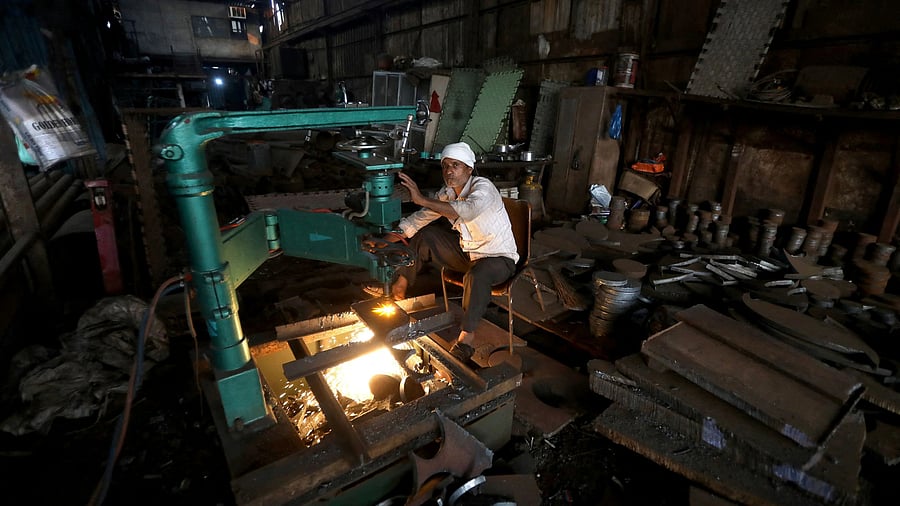
A worker operates a machine inside a small scale manufacturing unit in Mumbai.
Credit: Reuters Photo
India’s economy today stands at a crucial inflection point. On the one hand, the government and regulators are taking a far more proactive, forward-looking approach, while on the other, the banking system and overall liquidity conditions are witnessing notable shifts. This raises an important question: Is India entering a new phase of economic growth? If yes, then what could be the key triggers powering this next leg, and what headwinds should investors expect?
India’s current economic condition
In the April-June quarter of FY26, India recorded a 7.8% YoY GDP growth, the fastest in five quarters, compared with 5.6% in the same quarter last year.
Government spending rebounded with a growth of 7.5%, aided by early fund disbursements and higher allocations. Investment activity remained healthy, with gross fixed capital formation up by 7.8%, driven by significant increase in government capital expenditure. Exports grew 6.3%, despite global trade challenges, supported by strong demand from markets such as the US.
The IMF expects India to grow faster than earlier estimates despite the US tariff impact.
GST cuts, infra push, and export promotion
A recent GST rate cut supported festive demand, with auto sales reaching record monthly volumes and spending on jewellery, electronics, apparel, furnishings, and sweets crossing Rs 6 lakh crore between September 22 and October 21, up 8.5% from last year. Despite the GST cut, gross collections in October rose 4.6% to about Rs 1.96 lakh crore, reflecting strong domestic consumption.
Infrastructure spending has increased significantly, with capital expenditure rising from Rs 2 lakh crore in 2014-15, to Rs 11.21 lakh crore in 2025-26 — about 3.4% of GDP. The government is currently fast-tracking mega projects, including bullet train corridors, large shipbuilding yards, multiple ports, and highway expansions, under the Viksit Bharat 2047 vision.
Furthermore, to counter US tariffs, the government launched the Export Promotion Mission on November 13, with Rs 25,060 crore to be disbursed over six years, supporting sectors like textiles, leather, gems and jewellery, engineering goods, and marine products to boost exports.
Monetary easing and liquidity push by RBI
The RBI has introduced several measures to maintain adequate liquidity. These include Open Market Operations worth Rs 1.25 lakh crore and a 100-basis-point reduction in the Cash Reserve Ratio, implemented in phases, which released around Rs 2.7 lakh crore into the banking system.
Bank credit growth rose from 10.2% in early September, to 11.3% by mid-October, supported by festive spending and GST rate cuts. The repo rate has also been reduced to 5.50%, lowering borrowing costs.
Retail inflation fell to a historic low of 0.25% in October 2025. With inflation well below the RBI’s 4% target, the environment appears conducive for further easing in the December 2025 policy review.
Are we really entering a new phase?
Recent indicators point toward a potential shift into a stronger economic phase for India. The growth cycle appears to be bottoming out, supported by falling crude oil prices, expectations of a normal monsoon, and a stable interest-rate environment.
India’s investment cycle is showing some signs of revival. Government spending on infrastructure and manufacturing remains robust, while private investments are gradually strengthening. The real estate sector is recovering, and fresh opportunities are emerging in renewable energy, supply-chain localisation, and advanced technology components.
Market conditions also remain favourable. Nifty valuations hover slightly above their 10-year average, and the RBI recently raised its GDP growth forecast for FY26 to 6.8%. A true ‘new phase’ would mean more structural improvements, sustained higher growth, broader sector participation, and a shift in growth drivers toward investment-led expansion.
Challenges to India’s growth momentum
Global headwinds: Slow growth in the US and Europe, rising geopolitical tensions, and unpredictable trade policies remain a concern.
Foreign investors: FIIs have been selling for four straight months, adding stress to financial markets, although September outflows were not very large.
Currency pressure: The rupee has weakened through 2025 due to a strong US dollar, elevated oil prices, and FII outflows, though recent signs of a potential US-India trade agreement have helped stabilise it.
Corporate earnings: Analysts expect the markets to stay range-bound until earnings growth reaches a steady 12-15%. Much of the recent earnings strength is limited to commodity-linked sectors.
Private investment: A predictable business environment, faster approvals, and stronger governance are needed to attract long-term capital.
Sectors likely to drive India’s next growth cycle
Capital Goods & Infrastructure: Strong government capex and multi-year project pipelines will drive construction, industrial equipment demand, and logistics expansion.
Manufacturing: Electronics, PLI-linked sectors, semiconductors, components, and renewable energy equipment stand out as global supply chains diversify.
Banking & Financial Services: A cleaner banking system, falling NPAs, and double-digit loan growth position BFSI as an outperformer.
Aerospace & Defence: Rising indigenisation and multi-year order visibility make this a long-term structural theme.
Renewable Energy & EVs: Green capacity addition, battery storage, and EV adoption will support multi-decade opportunities.
India’s economic momentum is clearly strengthening, with Ind-Ra projecting 7.2% GDP growth for Q2 FY26, supported by resilient private consumption and a robust services sector. As the economy enters a new growth phase, the next big opportunity lies in reviving private investment, backed by policy tailwinds, rising household incomes, and macroeconomic stability.
(The writer is Vice President — Research, Teji Mandi)